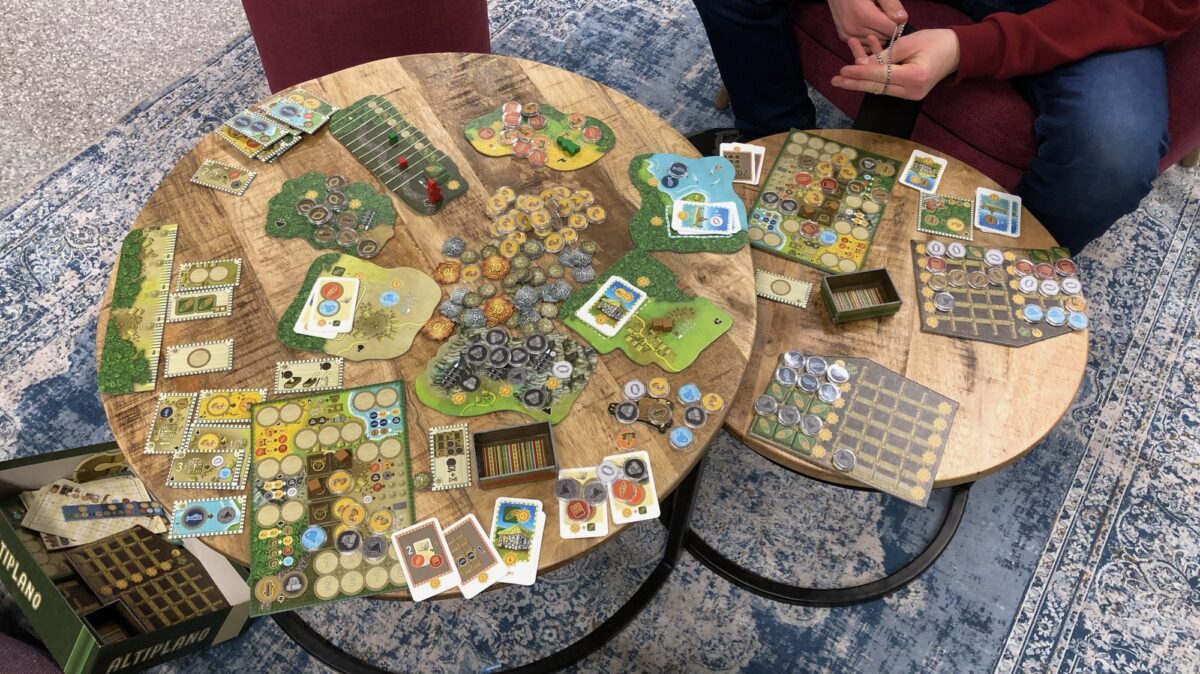While my daughter is cheerleading, I’ve spent the time walking. Now that it’s cold and dark outside, walking isn’t as much fun, so I ended up spending the time in the local library, reading books or doing crossword puzzles.
Then we realized my son could join me and we could spend the time playing games! There’s an hour, and that’s plenty.
The local library is a small temporary space, but it’s pretty cosy and has a good table. However, that good table was taken yesterday, so we had to do with a smaller sofa table. As you can see from the header, we had no trouble fitting Altiplano on the table.
Multiplayer solitaire of the most miserable kind. Players will have almost no effect on each other, but you still need to strictly enforce sequencing just since there’s a couple of potential interaction points.
Juho Snellman on Altiplano
Altiplano does require a lot of space, but fortunately for this table, the space required is very flexible and doesn’t need to be a large rectangular area. As Dave Kudzma says on BGG: “One big negative is the footprint; this game is as big as many may have lead you to believe. I’m entirely positive they could have gone with a board rather than the island/plateaus and gotten the same effect in a smaller space.” Perhaps indeed, but I do appreciate the separate boards having played Altiplano on small tables a couple of times.
I’ve now played Altiplano 24 times, and I still like it quite a bit. It’s a quick game; a two-player game plays in 20–30 minutes. It’s almost wholly solitaire, and I kind of wish it was just a bit more. I’m not as strict as Juho Snellman is (he rates Altiplano a generous 3), but yeah, that’s unfortunate. The problem isn’t as pronounced with two players, but it would be better to just program and then implement without worrying about the sequencing.
I don’t mind solitaire, and I like the puzzle in this game. What I find fascinating in Altiplano is how hard it can be to produce certain vital materials. There’s no always-available method of producing fish or alpacas, for example. You can have one on your individual character tile, or you can buy one during the game, but it may well be you can’t produce a single fish during the match. The way that bars whole parts of the game is curious and one of the reasons I think Altiplano stays fresh. If you take the character tiles randomly, you can’t get stuck in a specific strategy.

Thanks to the library sessions, I also have played The City. I used to like this game a lot, enough to create my own Tampere-themed version, because back in the day, there was only the ugly German edition available.
I’m getting closer to 100 plays with The City. BGG lists the game length at 30 minutes, while the Amigo box says 20 minutes; five minutes is closer to the truth. This is a super-fast game, and that’s why it’s so good and useful, and that’s also what makes me forgive the game for all the flaws it has.
Not that it has many. I think the biggest issue is how good the shopping cart strategy can be. Einkaufspassage is the best card in the deck; I think it could well be priced 3, and it’d still be excellent. It’s by far the best card to begin the game with since it’s so easy to feed with shopping cart cards, which quickly leads to explosive income and makes it easier to fish for Einkaufszentrum, Handelszentrum or both for massive points.
Car and fountain strategies can be good, too. Villas rarely are, though they’re tempting: it’s hard to get enough of them. And of course, sometimes your game just falls flat, and you can’t win. These flaws would be terrible in a longer game, even in a 30-minute game. In a five-minute game? Not a big deal. Just play again! I’m glad to have The City on the rotation again.
